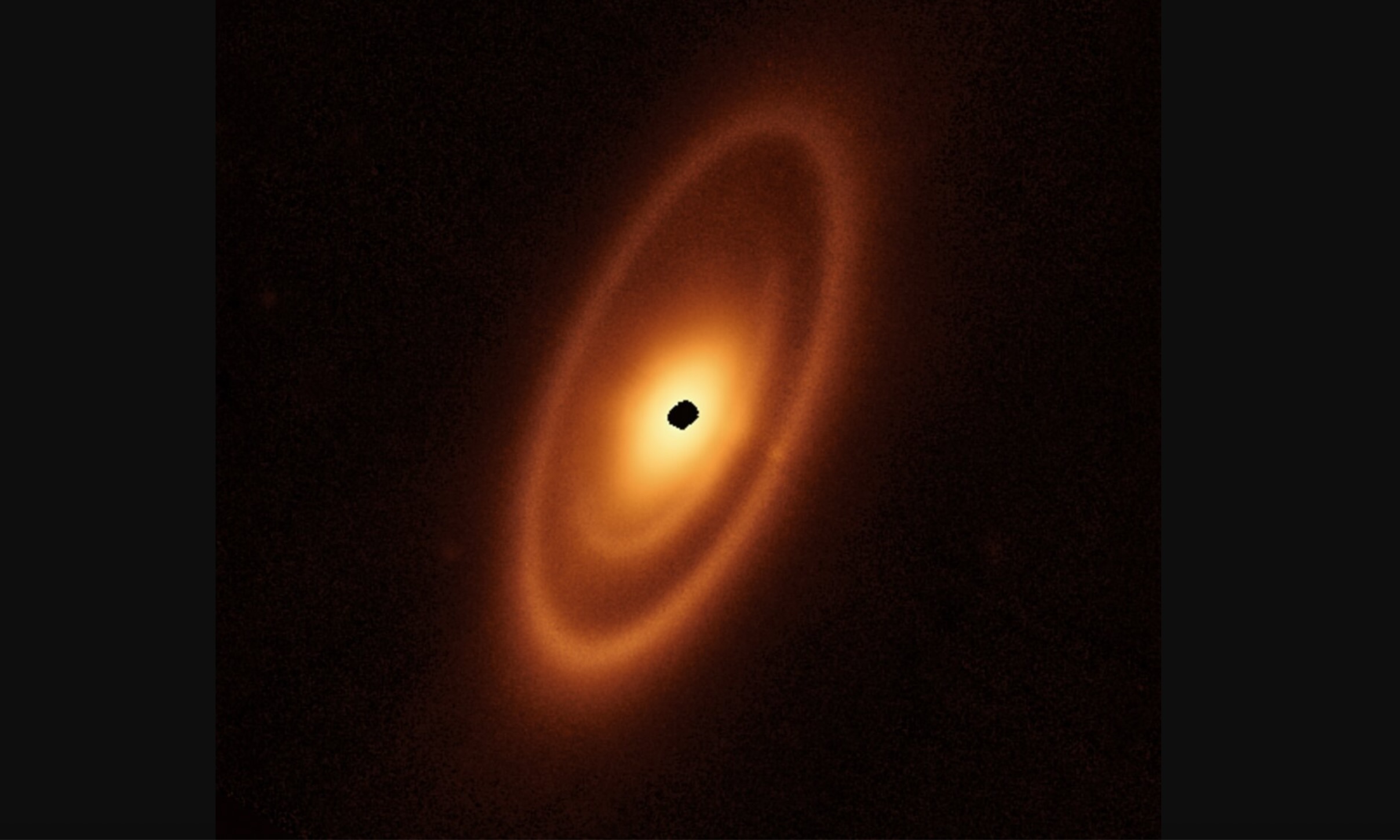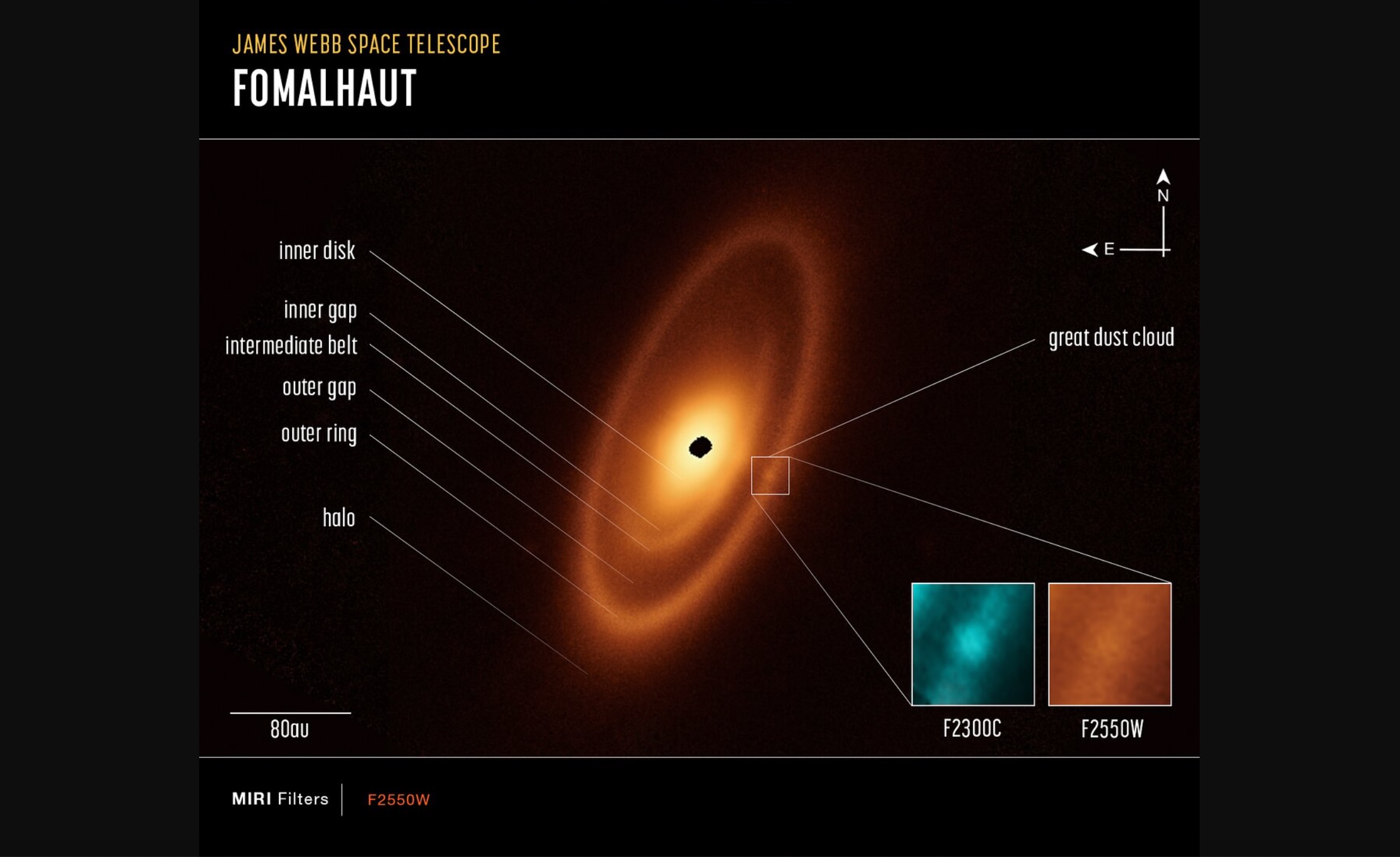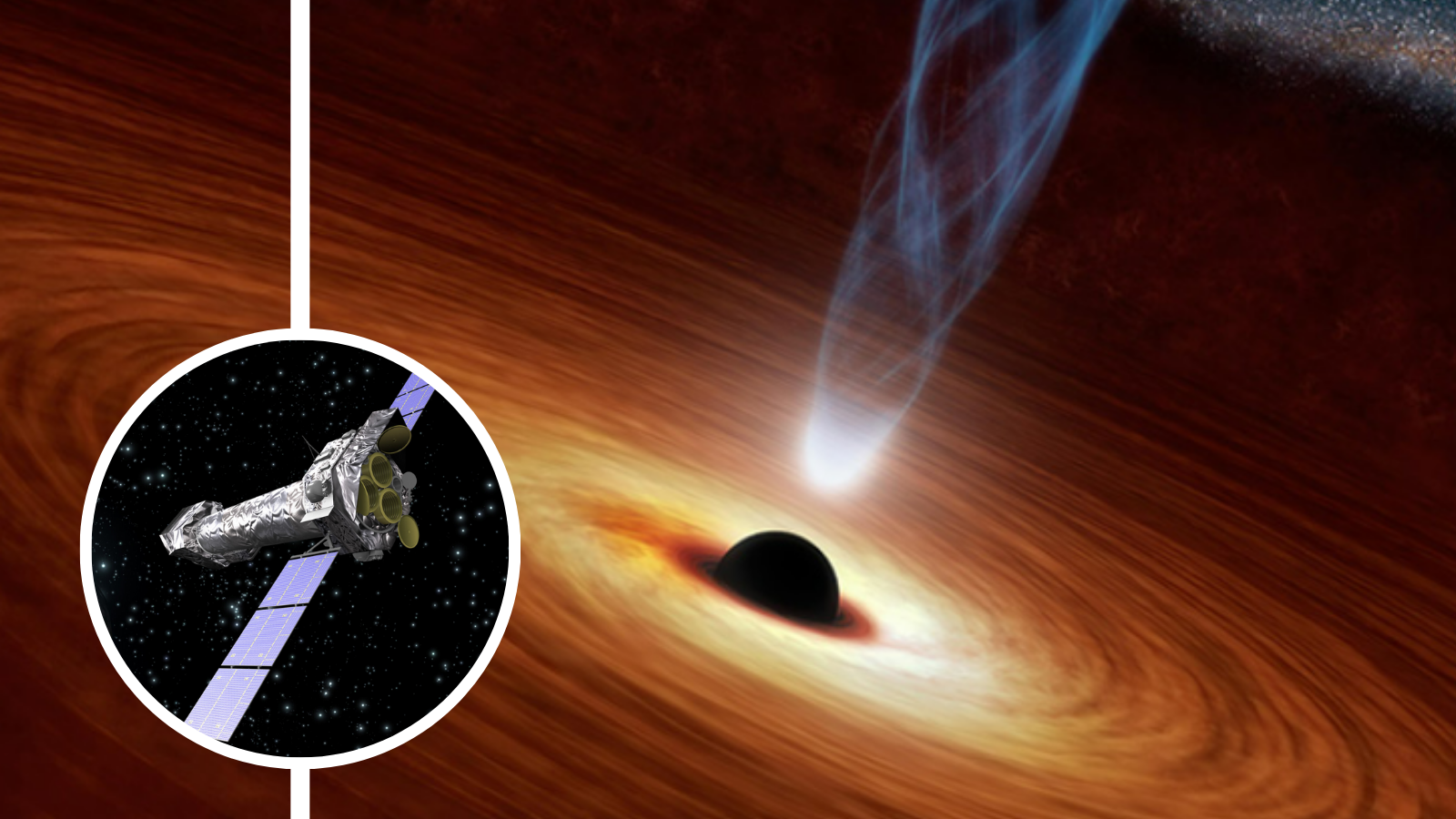James Webb Space Telescope snaps amazing photo of alien asteroid belt
The debris structures around the star Fomalhaut are more complex than comparable features in our own solar system.

The first asteroid belt ever found outside the solar system is more complex than expected, new observations by the James Webb Space Telescope (JWST) reveal.
Astronomers used JWST to examine the dusty ring system around Fomalhaut, a young, hot star that lies about 25 light-years from Earth and is visible with the naked eye in the constellation Piscis Austrinu, the Southern Fish.
Fomalhaut's ring system consists of three nested belts that extend out for around 14.3 billion miles (23 million kilometers) — about 150 times the distance between Earth and the sun. The rings are more complex than either the Kuiper Belt, a ring of frigid bodies beyond Neptune, or the main asteroid belt, which sits between Jupiter and Mars, the new JWST observations show.
Related: 12 amazing James Webb Space Telescope discoveries

Astronomers discovered a dusty structure surrounding Fomalhaut in 1983 using NASA's Infrared Astronomical Satellite. Yet the two inner belts of this system had never been sighted before this observation with the JWST.
The dust belts around the young star are thought to be debris from collisions between larger bodies like asteroids and comets, and are therefore referred to as "debris disks." These disks are different than protoplanetary disks, which hold material that later gloms together to form planets. Debris disks form later, after planets are in place.
"I would describe Fomalhaut as the archetype of debris disks found elsewhere in our galaxy, because it has components similar to those we have in our own planetary system," András Gáspár of the University of Arizona, the lead author of a study announcing the new results, said in a statement.
Breaking space news, the latest updates on rocket launches, skywatching events and more!
"By looking at the patterns in these rings, we can actually start to make a little sketch of what a planetary system ought to look like — if we could actually take a deep enough picture to see the suspected planets," Gáspár added.
Fomalhaut's outermost belt, which is twice as large as the Kuiper Belt, has been imaged previously by the Hubble Space Telescope, the Herschel Space Observatory and the ground-based Atacama Large Millimeter/submillimeter Array (ALMA). None of those instruments were able to see the interior structure within the outer belt, however.
"Where the JWST really excels is that we're able to physically resolve the thermal glow from dust in those inner regions. So you can see inner belts that we could never see before," study team member Schuyler Wolff, also of the University of Arizona, said in the same statement.
Going forward, astronomers hope to image debris disks like Fomalhaut's around other stars using JWST.
"With Hubble and ALMA, we were able to image a bunch of Kuiper Belt analogs, and we've learned loads about how outer disks form and evolve," Wolff continued. "But we need the JWST to allow us to image a dozen or so asteroid belts elsewhere. We can learn just as much about the inner warm regions of these discs as Hubble and ALMA taught us about the colder outer regions."
Just like Jupiter dominates the main asteroid belt and Neptune sculpts the Kuiper Belt, astronomers believe that debris disks outside the solar system may be shaped by unseen planets. That means there may well be a planet or two lurking in the rings around Fomalhaut.
"We definitely didn't expect the more complex structure with the second intermediate belt and then the broader asteroid belt," Wolff said. "That structure is very exciting, because any time an astronomer sees a gap and rings in a disk, they say, 'There could be an embedded planet shaping the rings!'"
One feature already spotted by JWST in the rings may indicate the presence of forming protoplanets. The team saw what Gáspár labeled "the great dust cloud," which may point to a collision in the outer ring of Fomalhaut between two "under construction" infant planets. This feature could therefore be an expanding cloud of very fine dust particles from two icy bodies that smashed into each other.
A similar feature was spotted in the same ring by Hubble back in 2008. It had dissipated by the time the space telescope reexamined the ring system in 2014, researchers said.
Deeper investigations of more systems like Fomalhaut with JWST could reveal how planets move through these pancake-flat disks. Observing the dust cloud itself, meanwhile, could reveal details about the structure of planetary systems other than our own. This includes discovering what their asteroids — which are much too small to see even with powerful instruments like JWST or Hubble — are like, and if they are similar to the space rocks that swirl around our star and its planets.
The team's research was published online Monday (May 8) in the journal Nature Astronomy.
Follow us on Twitter @Spacedotcom or on Facebook.
Join our Space Forums to keep talking space on the latest missions, night sky and more! And if you have a news tip, correction or comment, let us know at: community@space.com.

Robert Lea is a science journalist in the U.K. whose articles have been published in Physics World, New Scientist, Astronomy Magazine, All About Space, Newsweek and ZME Science. He also writes about science communication for Elsevier and the European Journal of Physics. Rob holds a bachelor of science degree in physics and astronomy from the U.K.’s Open University. Follow him on Twitter @sciencef1rst.
-
rod The ref paper cited abstract is interesting too. Ref - Spatially resolved imaging of the inner Fomalhaut disk using JWST/MIRI, https://www.nature.com/articles/s41550-023-01962-6, 08-May-2023. "Abstract Planetary debris disks around other stars are analogous to the asteroid and Kuiper belts in the Solar System. Their structure reveals the configuration of small bodies and provides hints for the presence of planets. The nearby star Fomalhaut hosts one of the most prominent debris disks, resolved by the Hubble Space Telescope, Spitzer, Herschel and the Atacama Large Millimeter Array. Images of this system at mid-infrared wavelengths using JWST/MIRI not only show the narrow Kuiper belt-analogue outer ring, but also that (1) what was thought from indirect evidence to be an asteroid-analogue structure is instead broad, extending outward into the outer system, and (2) there is an intermediate belt, probably shepherded by an unseen planet. The newly discovered belt is demarcated by an inner gap, located at ~78 au, and it is misaligned relative to the outer belt. The previously known collisionally generated dust cloud, Fomalhaut b, could have originated from this belt, suggesting increased dynamical stirring and collision rates there. We also discovered a large dust cloud within the outer ring, possible evidence of another dust-creating collision. Taken together with previous observations, Fomalhaut appears to be the site of a complex and possibly dynamically active planetary system."Reply
Makes me wonder just how much dust and gas is present still, Fomalhaut is said to be some 440E+6 years old (Wikipedia) and mass near 1.92 Msun. My observation. Wikipedia shows properties for Fomalhaut star. Given 1.92 Msun, total dust using MMSN could be 6.392501E+01 (about 64) earth masses but the JWST observations and reporting look like much more found. I did not see a specific amount disclosed. The total dust and gas disc mass could be 6.392501E+03 earth masses but the star's age is said to be 440E+6 years old. So far, no planets are seen in the disc. Some reports in the past are not confirmed now, http://exoplanet.eu/catalog/ -
rod I found this past report on the dust in debris disc of Fomalhaut, some 8-16 lunar masses or about 0.197 earth masses or less. Dust Production Rates in the Fomalhaut Debris Disk from SOFIA/FORCAST Mid-infrared Imaging, https://arxiv.org/abs/1806.09746, 26-Jun-2018. "We present the first spatially resolved mid-infrared (37.1 μm) image of the Fomalhaut debris disk...Under the assumptions that the dust grains are icy aggregates and the debris disk is in steady state, this result is consistent with the dust production rates predicted by Kenyon & Bromley (2008) from theoretical models of icy planet formation. We find a dust luminosity of (7.9±0.8)\00d710^−4 L⊙ and a dust mass of 8 -- 16 lunar masses, depending on grain porosity, with ∼1 lunar mass in grains with radius 1 μm -- 1 mm. If the grains are icy and highly porous, meter-sized objects must be invoked to explain the far-IR, submm, and mm emission. If the grains are composed of astronomical silicates, there is a dearth of blowout grains (Pawellek et al. 2014) and the mass loss rate is well below the predicted dust production values."Reply
My note, apparently JWST observations showed much more dust at Fomalhaut disk and much larger size in au too.
